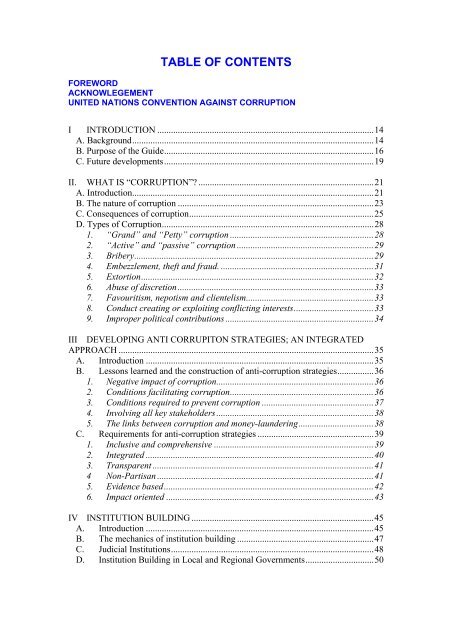UN Guide for Anti-Corruption Policies - United Nations Office on ...
UN Guide for Anti-Corruption Policies - United Nations Office on ...
UN Guide for Anti-Corruption Policies - United Nations Office on ...
Create successful ePaper yourself
Turn your PDF publications into a flip-book with our unique Google optimized e-Paper software.
TABLE OF CONTENTS<br />
FOREWORD<br />
ACKNOWLEGEMENT<br />
<str<strong>on</strong>g>UN</str<strong>on</strong>g>ITED NATIONS CONVENTION AGAINST CORRUPTION<br />
I INTRODUCTION ...............................................................................................14<br />
A. Background..........................................................................................................14<br />
B. Purpose of the <str<strong>on</strong>g>Guide</str<strong>on</strong>g>............................................................................................16<br />
C. Future developments............................................................................................19<br />
II. WHAT IS “CORRUPTION”? .............................................................................21<br />
A. Introducti<strong>on</strong>..........................................................................................................21<br />
B. The nature of corrupti<strong>on</strong> ......................................................................................23<br />
C. C<strong>on</strong>sequences of corrupti<strong>on</strong>.................................................................................25<br />
D. Types of <str<strong>on</strong>g>Corrupti<strong>on</strong></str<strong>on</strong>g>.............................................................................................28<br />
1. “Grand” and “Petty” corrupti<strong>on</strong> ...............................................................28<br />
2. “Active” and “passive” corrupti<strong>on</strong> ............................................................29<br />
3. Bribery.........................................................................................................29<br />
4. Embezzlement, theft and fraud. ...................................................................31<br />
5. Extorti<strong>on</strong>......................................................................................................32<br />
6. Abuse of discreti<strong>on</strong>......................................................................................33<br />
7. Favouritism, nepotism and clientelism........................................................33<br />
8. C<strong>on</strong>duct creating or exploiting c<strong>on</strong>flicting interests...................................33<br />
9. Improper political c<strong>on</strong>tributi<strong>on</strong>s .................................................................34<br />
III DEVELOPING ANTI CORRUPITON STRATEGIES; AN INTEGRATED<br />
APPROACH ................................................................................................................35<br />
A. Introducti<strong>on</strong> ....................................................................................................35<br />
B. Less<strong>on</strong>s learned and the c<strong>on</strong>structi<strong>on</strong> of anti-corrupti<strong>on</strong> strategies................36<br />
1. Negative impact of corrupti<strong>on</strong>.....................................................................36<br />
2. C<strong>on</strong>diti<strong>on</strong>s facilitating corrupti<strong>on</strong>...............................................................36<br />
3. C<strong>on</strong>diti<strong>on</strong>s required to prevent corrupti<strong>on</strong> .................................................37<br />
4. Involving all key stakeholders .....................................................................38<br />
5. The links between corrupti<strong>on</strong> and m<strong>on</strong>ey-laundering.................................38<br />
C. Requirements <str<strong>on</strong>g>for</str<strong>on</strong>g> anti-corrupti<strong>on</strong> strategies ...................................................39<br />
1. Inclusive and comprehensive ......................................................................39<br />
2. Integrated ....................................................................................................40<br />
3. Transparent .................................................................................................41<br />
4 N<strong>on</strong>-Partisan ...............................................................................................41<br />
5. Evidence based............................................................................................42<br />
6. Impact oriented ...........................................................................................43<br />
IV INSTITUTION BUILDING ................................................................................45<br />
A. Introducti<strong>on</strong> ....................................................................................................45<br />
B. The mechanics of instituti<strong>on</strong> building ............................................................47<br />
C. Judicial Instituti<strong>on</strong>s.........................................................................................48<br />
D. Instituti<strong>on</strong> Building in Local and Regi<strong>on</strong>al Governments..............................50

















